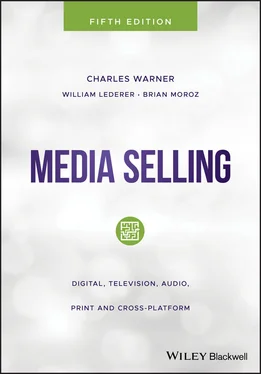As inexperienced direct accounts gain experience, their needs shift from asking for marketing and advertising advice to asking for responsive service and competitive prices. However, one thing direct accounts, especially retailers, will always focus on is results, which will always be more important to them than ratings, circulation, or research data. In the following sections of this chapter, you will learn more about strategies for calling on direct accounts and on agencies.
Missionary selling most often involves calling on the principle owner, the CEO, or director of marketing or advertising of an account. Calling directly on an account and not on the account’s advertising agency, if the account has one, is referred to as direct selling . Often, direct selling, particularly in local media, entails calling on retail businesses. The information that follows is for calling on retail businesses, but it also applies to most direct selling.
Retailers are the middlemen between manufacturers and consumers, and advertising plays an important role because retailers sell their goods in a highly competitive environment. Few businesses that start up survive; two out of every three new retail businesses will fail within one year. Changes in the nation’s demographics, lifestyles, and buying habits have caused many of the more traditional retailers to rethink their strategies, especially because of Amazon’s dominance in online shopping. Single‐brand loyalty has declined, and mass‐marketing techniques have been developed to accommodate the proliferation of new products. Consumer groups that used to share homogeneous tastes have now splintered into many groups, all demanding different products to meet their different and changing needs.
Amazon’s incredible growth, customer focus, ease of use, and fast home delivery policies have decimated large and small retail businesses, as have the proliferation of direct‐to‐consumer marketed products such as Harry’s shaving products, Quip toothbrushes, and Blue Apron’s meal kit service.
Retailers have had to change their ways of doing business to satisfy and attract consumers who are generally better educated, more cynical of product claims, and more demanding of quality. To entice these consumers, advertising and promotion have become more important than ever before, and most retailers now use digital advertising, especially search advertising on Google, to reach consumers who are looking for a product online because they are in the market to buy the product. When someone is in the market to buy a product, they are referred to as intenders . If retailers want to reach intenders, they will almost certainly buy self‐serve search advertising in a Google Ads auction.
If retailers want to buy demographically – for consumers who are in the precise targeted demographic – they will almost certainly buy ads on Facebook. Therefore, salespeople who sell for other media such as local radio, local television, or newspapers must be prepared to help their customers buy Google and Facebook ads and be able to show how their medium complements ads on these two giant online platforms.
Retail is a broad category for which there is no standard definition; stores (hard goods, soft goods, food), services (insurance companies, banks, dry cleaning), entertainment (theaters, clubs, bars), and restaurants all normally come under the general classification of retail. In this book, all types of retail establishments and sellers of services are referred to as stores . For example, those businesses that are results‐oriented should be designated as retail clients, or retail accounts, and have missionary salespeople calling on them. A retailer may have an advertising agency that buys according to the dictates of a store owner who cares only about results and who directs the agency to buy in a particular pattern that has proven to be successful in the past. These types of agency and direct accounts should be called on by a retail specialist. A retail specialist is a salesperson who thoroughly understands the retail business and who might have had experience working in retail.
A retail salesperson must be patient and not always seek a fast sale or a quick close. It may take much longer to sell to a retailer who is trying to fit advertising into a complex marketing and merchandising mix than to an advertising agency that is merely trying to make an efficient media buy.
Service selling entails calling on existing customers and partners, and most often involves calling on advertising agencies.
The advertising agency business
Advertising agencies came into existence in the 1880s when they sprang up as sales representatives for newspapers and magazines. As sales representatives for the media, they kept a 15 percent commission on the amount of money advertisers spent with them in the media they represented. Thus, an advertiser might spend $1,000 for ads in a magazine and the agencies would keep $150 and give $850 to the magazine. As time went on, the agencies got close to their advertisers and began to create advertising for them and to advise where to place it. The agencies maintained the practice of keeping 15 percent of the amount the advertisers spent in the media through the late 1980s, when the agency business began to change as more and more independent agencies were purchased by large agency holding companies such as WPP, Omnicom, Publicis, IPG, Havas, and Dentsu. As competition for large accounts intensified, the holding company agencies began to compete for business on price, or lower commissions and fees. The fierce competition among the holding company agencies accelerated a trend of decreasing commissions. This trend was acerbated by large advertisers that often turned over the negotiating of agency commissions and fees to their purchasing departments, which brought on the use of negotiated fees based on scope of work (SOW).
Agencies also make money by adding a 15 percent commission to the material, services, and production they purchase for a client, a practice that is referred to as grossing up a charge. For example, if an agency purchases $850 worth of photography for a client, it would gross it up 17.65 percent (or multiply $850 by 1.1765) and charge the client $1,000. (You may recall from basic high school algebra that you cannot take a 15 percent discount off the price of some product and then multiply the discounted price by 1.15 to get the original number; the two values will not be equal. For example, 15 percent less than 100 is 85, but 1.15 times 85 equals only 97.7.)
Advertising agencies are service businesses and their expenses are mostly for people: copywriters, designers, art directors, media buyers, media planners, account management people, and so forth. The fees ad agencies charge are typically based on the following: (1) a monthly retainer fee against which media commissions are credited, (2) an agreed‐upon charge per hour for work performed, or (3) a complex formula related to the amount of work the agency performs for a client as a percentage of the agency's total overhead. One reason that the fee arrangement is preferred by many advertisers is that they do not want their agency’s income to depend on how much money they invest in the media. Advertisers want to make sure the agencies place their ad dollars as efficiently as possible and that the agencies buy the most effective, not necessarily the most expensive, media.
Advertising agencies vary in size from large conglomerates with more than 50,000 employees in offices throughout the world and with media billings in the tens of billions of dollars to local, one‐person agencies in smaller towns with media billings in the thousands of dollars.
Читать дальше












